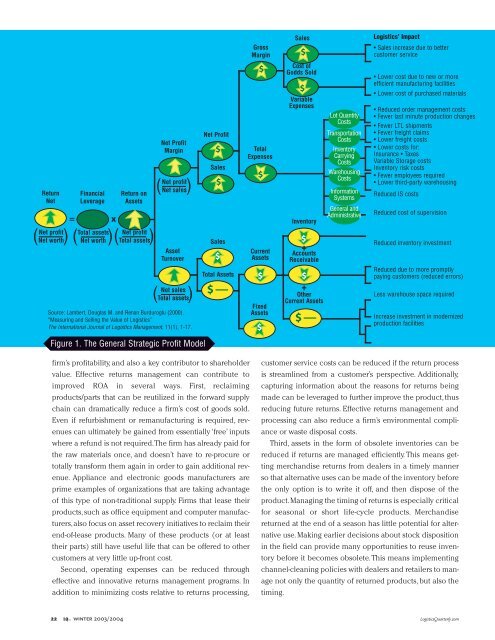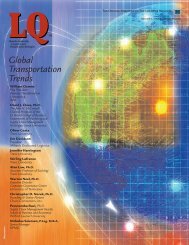Reverse Logistics - Logistics Quarterly
Reverse Logistics - Logistics Quarterly
Reverse Logistics - Logistics Quarterly
You also want an ePaper? Increase the reach of your titles
YUMPU automatically turns print PDFs into web optimized ePapers that Google loves.
Return<br />
Net<br />
Net profit ( Net worth)<br />
=<br />
Financial<br />
Leverage<br />
x<br />
Total assets ( Net worth)<br />
firm’s profitability, and also a key contributor to shareholder<br />
value. Effective returns management can contribute to<br />
improved ROA in several ways. First, reclaiming<br />
products/parts that can be reutilized in the forward supply<br />
chain can dramatically reduce a firm’s cost of goods sold.<br />
Even if refurbishment or remanufacturing is required, revenues<br />
can ultimately be gained from essentially ‘free’ inputs<br />
where a refund is not required.The firm has already paid for<br />
the raw materials once, and doesn’t have to re-procure or<br />
totally transform them again in order to gain additional revenue.<br />
Appliance and electronic goods manufacturers are<br />
prime examples of organizations that are taking advantage<br />
of this type of non-traditional supply. Firms that lease their<br />
products, such as office equipment and computer manufacturers,also<br />
focus on asset recovery initiatives to reclaim their<br />
end-of-lease products. Many of these products (or at least<br />
their parts) still have useful life that can be offered to other<br />
customers at very little up-front cost.<br />
Second, operating expenses can be reduced through<br />
effective and innovative returns management programs. In<br />
addition to minimizing costs relative to returns processing,<br />
22 LQ winter 2003/2004<br />
Return on<br />
Assets<br />
Net profit ( Total assets)<br />
Net Profit<br />
Margin<br />
Net profit ( Net sales)<br />
Asset<br />
Turnover<br />
Net sales ( Total assets)<br />
Source: Lambert, Douglas M. and Renan Burduroglu (2000).<br />
“Measuring and Selling the Value of <strong>Logistics</strong>”<br />
The International Journal of <strong>Logistics</strong> Management, 11(1), 1-17.<br />
Figure 1. The General Strategic Profit Model<br />
Net Profit<br />
$<br />
Sales<br />
$<br />
Sales<br />
$<br />
Total Assets<br />
$–<br />
Gross<br />
Margin<br />
$<br />
Total<br />
Expenses<br />
$<br />
Current<br />
Assets<br />
$<br />
Fixed<br />
Assets<br />
$<br />
Sales<br />
$<br />
Cost of<br />
Godds Sold<br />
$<br />
Variable<br />
Expenses<br />
Inventory<br />
$<br />
+<br />
Accounts<br />
Receivable<br />
$<br />
+<br />
Other<br />
Current Assets<br />
$–<br />
Lot Quantity<br />
Costs<br />
Transportation<br />
Costs<br />
Inventory<br />
Carrying<br />
Costs<br />
Warehousing<br />
Costs<br />
Information<br />
Systems<br />
General and<br />
Administrative<br />
<strong>Logistics</strong>’ Impact<br />
• Sales increase due to better<br />
customer service<br />
• Lower cost due to new or more<br />
efficient manufacturing facilities<br />
• Lower cost of purchased materials<br />
• Reduced order management costs<br />
• Fewer last minute production changes<br />
• Fewer LTL shipments<br />
• Fewer freight claims<br />
• Lower freight costs<br />
• Lower costs for:<br />
Insurance • Taxes<br />
Variable Storage costs<br />
Inventory risk costs<br />
• Fewer employees required<br />
• Lower third-party warehousing<br />
Reduced IS costs<br />
Reduced cost of supervision<br />
Reduced inventory investment<br />
Reduced due to more promptly<br />
paying customers (reduced errors)<br />
Less warehouse space required<br />
Increase investment in modernized<br />
production facilities<br />
customer service costs can be reduced if the return process<br />
is streamlined from a customer’s perspective. Additionally,<br />
capturing information about the reasons for returns being<br />
made can be leveraged to further improve the product, thus<br />
reducing future returns. Effective returns management and<br />
processing can also reduce a firm’s environmental compliance<br />
or waste disposal costs.<br />
Third, assets in the form of obsolete inventories can be<br />
reduced if returns are managed efficiently. This means getting<br />
merchandise returns from dealers in a timely manner<br />
so that alternative uses can be made of the inventory before<br />
the only option is to write it off, and then dispose of the<br />
product.Managing the timing of returns is especially critical<br />
for seasonal or short life-cycle products. Merchandise<br />
returned at the end of a season has little potential for alternative<br />
use. Making earlier decisions about stock disposition<br />
in the field can provide many opportunities to reuse inventory<br />
before it becomes obsolete.This means implementing<br />
channel-cleaning policies with dealers and retailers to manage<br />
not only the quantity of returned products, but also the<br />
timing.<br />
<strong>Logistics</strong><strong>Quarterly</strong>.com







